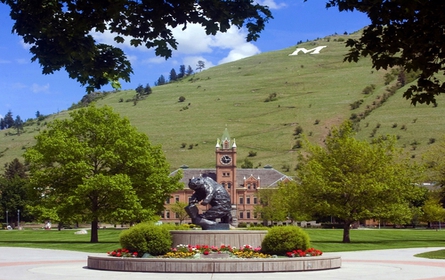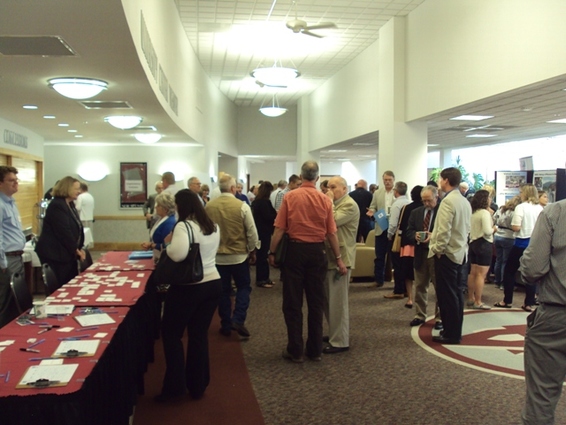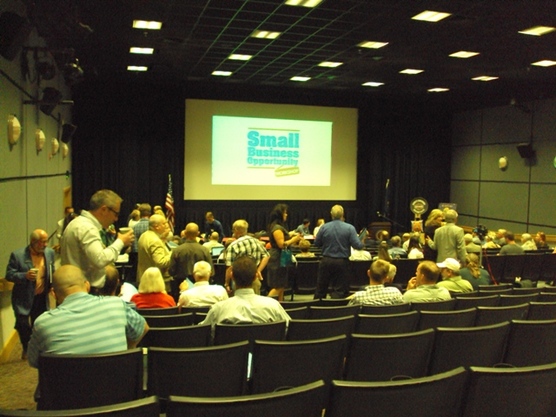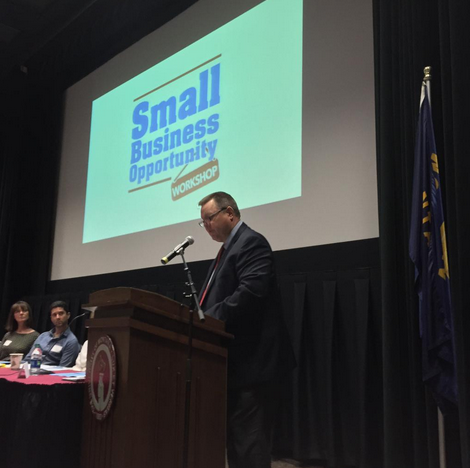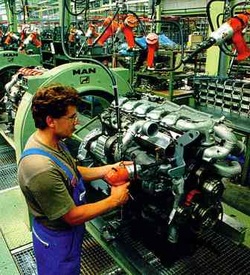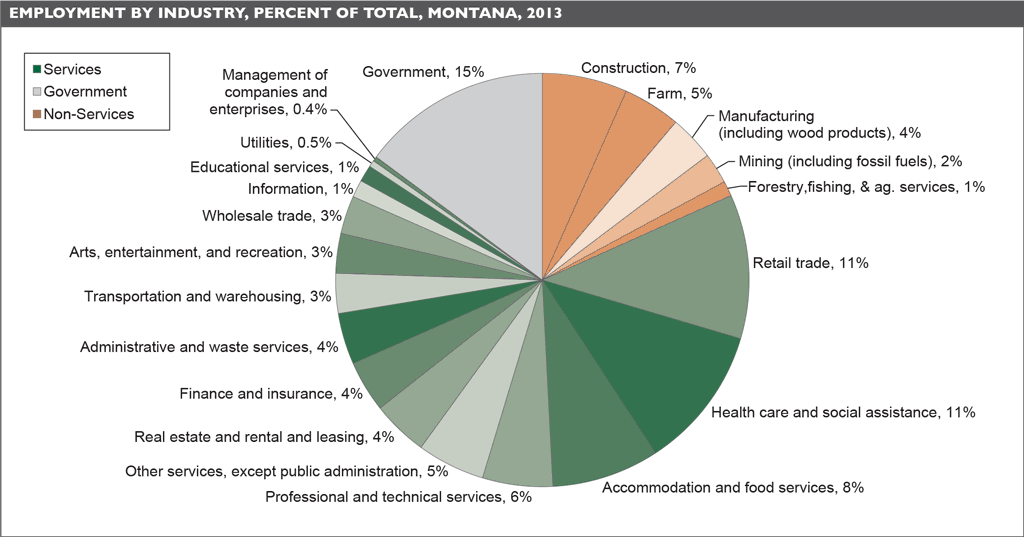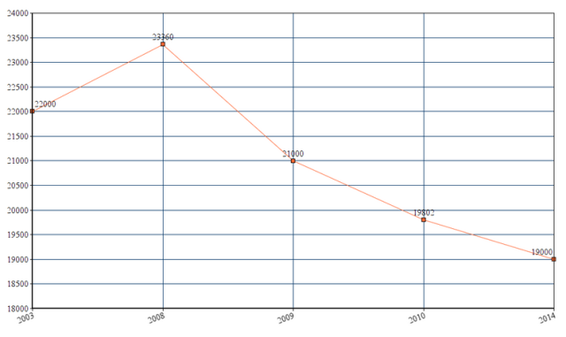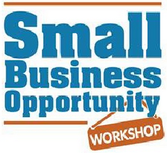
It took place in the Montana University of Montana’s University Center Theatre, which is on the 3rd floor of the UC.
Before we get into that, however, we need to discuss two things – parking and classes.
- First of all, where do I park for this thing? While just about every parking spot at the university is empty this time of year, most have signs saying “permit required.” Will UM President Engstrom ticket my ass? Knowing how hard up the school is for money right now, I decided not to take the chance and parked a few blocks in the housing district. That area required a residential permit, but I decided to chance it.
- Next, where are all the students? I took a stroll through campus before attending the workshop, and I was struck by the utter lack of people on campus. Sure, it’s close to 8 AM on a Friday, but gosh darn, I remember in 2006 busting my hungover ass up to class for both the June and July UM Summer Sessions. Are you telling me that those aren’t going on?
- Montana Small Business Association;
- Montana Procurement Technical Assistance Center;
- Prospera Business Network;
- Montana Women’s Business Center;
- Montana Manufacturing Association;
- Voices of Montana Tourism;
- Choose Montana;
- The USDA;
- And a few more.
He then got into business. He mentioned MonTec across the river, which started Rivertop Renewables and has three other startups according to its website. So that’s an “incubator center” that’s allowing businesses to start up. Engstrom wants to figure out how the university can help with that. He then pointed out James Grunke, who heads up the Missoula Redevelopment Center, an agency directly responsible for taking tax dollars and using those so private businesses can expand, at virtually no cost to them.
Tester got up after that and spoke. He mentioned how entrepreneurial Montana is, and applauded the university for working with business. He knows that small businesses are important because they “provide the state with the resources they need.”
American Manufacturing Stats
Manufacturing still makes up $2.09 trillion of the American economy, or 12% of GDP, and that’s gone up from the $1.73 trillion it was in 2009. It’s figured that every $1 used in manufacturing adds $1.37 to the economy.
In 2001 we had 16.9 million manufacturing jobs. The recession took care of most of those. There were 11.8 million manufacturing jobs in America in 2009. In 2014 there were 12.2 million manufacturing jobs. Today Manufacturing creates 12 million American jobs, and indirectly it creates 17.6 million jobs, making up 1/6 of our private sector jobs.
Those jobs pay well too. In 2013 the average American manufacturing worker could expect a salary of $77,506 a year. That’s quite a bit more than the $62,546 average that most American industries experience. And remember, these jobs have benefits and often retirement too. Multinational companies hate this, and do everything they can to end those American manufacturing jobs and send them overseas.
No other American industry is more productive than the manufacturing industry. More than 3/4 of all the American private sector R&D comes from the manufacturing industry. If taken alone, American manufacturing would be “the ninth-largest economy in the world,” according to a 2013 Bureau of Economic Analysis report.
So manufacturing is important in America, and we need more of it. You wouldn’t think that there’d be much in Montana, because let’s face it, when you think of manufacturing you usually think of things like this:
Montana Small Business Examples
Neil Stuber got up and talked about his business Hurraw! The business specializes in lib balm, and a couple women came around and passed out free samples to everyone in attendance. Pretty good idea, huh? Stuber mentioned that there are two main things that people need to focus on, and those are brand and demographic.
Robin Bequet got up next and talked about Bequet Confections, which has been operating for 13 years. She passed out some of the caramel that she makes and discussed how she got started. She’d been doing well at a job in 2001 when the Telecom bust came and she lost her job. On the day she was laid off a coworker came up and told her that she had the seed money to start a small business and wanted to start it with her. They had no idea what business, but there was some serious confidence there.
After that they got going and now she’s speaking at a small business workshop. She talked a lot about brand comparison, gathering data, and bootstrapping to save expenses. A lot of stuff was done to identify market niches, and they found six:
- Espresso shops;
- Natural food stores;
- Gourmet market or Deli;
- Montana gift shops;
- Corporate gifts;
- Candy stores.
We’re really getting into marketing here more than anything, and studying the market. She had to drive to cities around Montana and go and pitch her products herself. She mentioned how important reorders are, and how you want to identify this and why it’s important. She’s all about business, and even has the company cell phone number on the candy wrapper.
This is a small Montana business that added health insurance in 2007 and began offering 401(k) and other benefits a few years later. This is a good example of a Montana startup that’s helping 27 workers, plus another 25 seasonal workers.
Tester got up and asked them where they got the money to start. Stuber mentioned that you have to keep working your day job. Bequet mentioned that she did the same and even went back to work 40 hours a week when she was getting going, and even borrowed $30,000 against her home to get a caramel wrapping machine.
Montana Manufacturing Stats
By the 1990s, the services industry had overtaken manufacturing in Montana. In Montana in 2009 we had 17,500 manufacturing jobs. In 1997 Montana had been 41st in the nation in terms of manufacturing, but by 2010 we’d moved up to 36th. The best states in the country for manufacturing during those years were Indiana and Oregon, respectively.
What the Heck is Oregon Doing Right?
Oregon was the only state that didn’t experience declines in its manufacturing base from 1997 to 2013. Why is that, and what are they manufacturing over there? I mean, I don’t know about you, but when I think of Oregon I’m not thinking of manufacturing, I’m thinking of this:
When I talk about clean and green, high-tech Montana jobs, it’s those kinds of companies I’m talking about. They want the quality of life we provide here, sans the nutcases, so we need to get them here, bringing those good jobs.
In 2014 we had 19,200 manufacturing jobs in the state, which makes up 4.2% of our non-agricultural employment.
In 2009 the Columba Falls Aluminum Company effectively closed its doors for good. It hadn’t been employing as many workers as it had in its heyday. It’d opened in 1955 and had 1,500 workers when things were going good.
Montana had just over 22,000 manufacturing jobs in 2003. That number grew steadily, reaching 23,360 by 2008. Then the economic meltdown took place and the state began shedding manufacturing jobs like crazy. We were down to 21,000 manufacturing jobs by 2009 and in 2010 we had 19,802. That was the low point, and we slowly began to claw our way back, reaching 22,619 by 2013.
Much of Montana’s economic decline can really be traced to the 1980s. Changing trends hurt workers, and the dominant tourism and service industry jobs that rose up paid less. “Wages in the tourism industry won’t rise until workers demand they do,” Stephen Seninger said in 1999 when he was representing the Montana Bureau of Business and Economic Research.
Following the recession (which I believe we’re still in), manufacturing never fully recovered. Those tourism and service industry jobs took up most of what it used to have, if the workers didn’t just move away or quite the workforce entirely, perhaps relying on friends and family or the government.
Resources and commodity prices are also important, and those markets can be tricky. They affect manufacturing as you need them to make things.
The primary components of Montana’s manufacturing industry revolve around durable and nondurable goods.
One of the largest durable goods industries in the state is the fabricated metals product industry. In 2010 the sector had 1,890 workers but by 2013 they had 2,696, an increase of 43%. This is “everything from structural metal buildings to spring and wire products,” according to the 2015 State of Montana Manufacturing report. “Growth in small arms and ammunition manufacturing, which is concentrated in the western portion of the state, contributed most of the increase in fabricated metal products industry.”
Another sector of durable goods is nonmetallic minerals. REC Silicon in Butte is one of these companies. They started in the chemicals industry as ASiMi and switched over to nonmetallic minerals. They make “raw materials for the international solar and electronic industries” and employ nearly 300 workers.
For nondurable goods, the beverage and tobacco industry are the leaders. For beverages, we’re primarily talking about “craft breweries, distilleries, and tasting rooms.”
Montana manufacturing exports were $290.4 million in 2002 and then $880.7 million 2007. That fell to $876.5 million in 2009 but was up to $1.13 billion in 2012. They’ve since fallen 12% to $1.01 billion.
Conclusion
I can’t help but think we’ll lose out on much of this manufacturing history, mainly because the University of Montana is effectively shuttered this summer. The secretary for the history department is out from July 12 to 28 for God’s sake!
Usually that would be a good fount of information, but alas, UM doesn’t have the money in the budget to pay all the staff. Best to furlough them for a few months, hopefully with a good many using up their vacation time.
Montana manufacturing has been furloughed from it’s high point a decade ago, and we need to get that back. These workshops help with that, and hopefully some people will make connections and make some money. The state needs to figure out how it can be more like Oregon, leading the way in manufacturing. It can be done, and with Montana’s entrepreneurial spirit, it will.
You Might Also Like
How Missoula and Montana Will Attract Clean and Green Businesses (Mar 9, 2014)
Utah vs. Montana for Oil & Tech Jobs (Jul 23, 2014)
Should Montana Become a Reserve Airline Hub? (Sep 30, 2014)
How Montana’s Economy Has Changed Over 175 Years (Oct 10, 2014)
What’s the Dam News Today? (Nov 6, 2014)
Why is Montana Not Working? (Dec 12, 2014)
Tourists, Alkies and Overpaid Imbeciles Flock to Montana (Dec 21, 2014)
Looking at Montana Numbers from the 1990s (Dec 28, 2014)
Looking at Some 2015 Montana Economic News (Jan 6, 2015)
Harry Fritz’s Prescription for a Healthy Montana Economy (Jan 30, 2015)
Why is Montana Internet So Slow? (Feb 15, 2015)

